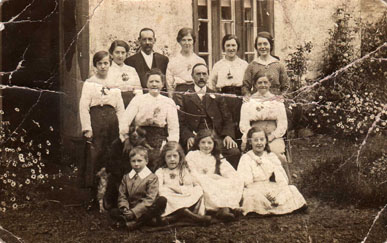Sign up for the Family Tree Newsletter Plus, you’ll receive our 10 Essential Genealogy Research Forms PDF as a special thank you!
Get Your Free Genealogy Forms
"*" indicates required fields

For my last column, I borrowed techniques from “Who Wants to be a Millionaire?”: I asked the audience and phoned a friend.
Several of you responded to my request for ideas about the blossoms on the ladies in this group portrait. Here’s what I learned:
A few folks suggested the flowers related to Mother’s Day, or because the photo was taken in England, Mothering Sunday. Linda Thompson asked, “When did people start observing Mother’s Day?”
That’s a good question. In the United States, Mother’s Day celebrations began because Anna Jarvis thought a holiday should commemorate mothers’ sacrifices for their families. Anna’s West Virgina hometown observed the first Mother’s Day in May, 1908, with a church service. President Woodrow Wilson gave the day national recognition in 1914.
England’s Mothering Sunday is much older, dating to the 1600s, and taking place on the fourth Sunday of Lent. Three Identifying Family Photographs readers—Thompson, Margaret Gaven and Ruth Haddow—wrote about the Mother’s Day tradition of wearing a pink or red flower if your mother is living and a white one if she’s passed away.
Having heard from the audience, I still wasn’t satisfied. I wanted to know what type of flower these people pinned to their hearts, and whether they were celebrating Mothering Sunday or Mother’s Day. I called my good friend Debbie (she’s modest, and wouldn’t let me give her last name), a master gardener. That means she knows a lot about plants. She studied and researched this photo for at least an hour, then announced all the adults are wearing the same old-fashioned rose on the bushes visible on the right side of the picture. The Black-eyed Susans growing on both sides of the group suggest the picture was taken in the summer, not the early spring when Mother’s Day is celebrated. After examining an enlarged photo (especially the girl seated next to the boy), Debbie determined the little girls are wearing ribbon roses.
Three of you questioned my observation that the woman in the print dress isn’t wearing a flower. Thanks to Donna Pilcher, Fred Tyree and Barbara Essam Gray for your powers of observation: I took another look, and she indeed has a flower. It’s mostly hidden by the head of the woman in front of her.
One photo makes two columns. This is a perfect example of how much your family photos have to say if you look closely enough. <!–
Watch for props. –><!–
2000–>
ADVERTISEMENT

